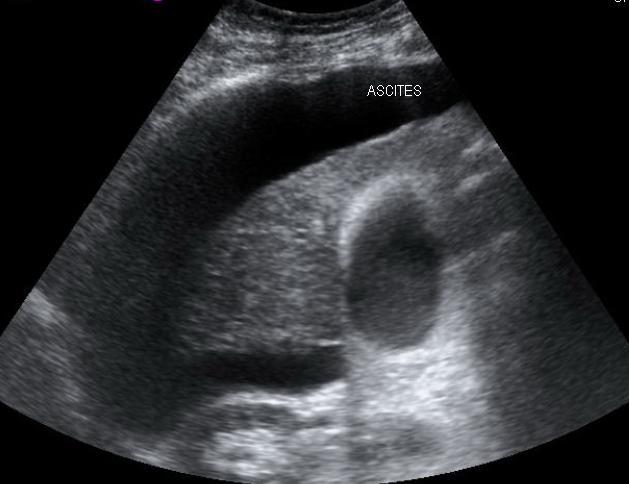Difference Between Ascites and Bloating
Both ascites and abdominal bloating involve swelling, sense of fullness, and discomfort. Also, one symptom of ascites is abdominal bloating. Regarding their difference, ascites is the buildup of fluid in the abdomen while abdominal bloating is the sensation of having an overfull stomach which is generally associated with gas buildup. Their distinctions are discussed below.

What is Ascites?
Ascites, from the Greek word “askos” which means bag or sac, is the buildup of fluid in the abdomen. The buildup happens between two membrane layers which make up the smooth sac that lines the abdominal cavity. The symptoms include swelling in the abdomen, weight gain, bloating, sense of heaviness and fullness, shortness of breath, vomiting, hemorrhoids, constipation, urinary urgency, and swelling in the lower legs. People with severe ascites may experience abdominal and back pain and may have difficulties in moving around (Johns Hopkins, 2021).
Ascites is a symptom of another underlying condition. The most common causes are liver disease, heart failure, and cancer (which affects the peritoneum, liver, lymphatic system, ovaries, breast, stomach, pancreas, bowels, lungs, or uterus). Other causes typically include tuberculosis, kidney disease, pancreatitis, and an underactive thyroid (Ingleson, 2017).
The treatments include “water pills” or diuretics such as Lasix and Aldactone, paracentesis (removing excess fluid by inserting a needle into the belly), and low-liquid and low-salt diet. In certain cases, a surgery to place a shunt in the liver or replace it is considered (Nazario, 2020).

What is Bloating ?
Abdominal bloating is the sensation of having an overfull stomach (Brennan, 2020). It occurs when the gastrointestinal tract is filled with gas. The symptoms include feeling full, a swollen or tight abdomen, pain, flatulence, frequent burping, and abdominal rumbling. Abdominal bloating is common among both children and adults; the causes include eating or drinking too fast, smoking, chewing gum, and wearing loose dentures (Donohue, 2020).
The buildup of gas may also be caused by certain foods such as cruciferous vegetables (e.g., cabbage, broccoli, etc.), stomach infection, indigestion, small intestinal bacterial overgrowth (SIBO), fluid retention, food intolerances, chronic disorders (e.g., irritable bowel syndrome and Crohn’s disease), gastroparesis, gynecological disorders, and constipation. Less common causes include gallbladder diseases, cancers of the stomach or intestines, and ascites (Villines, 2020).
The remedies and treatments include exercise, posture adjustment, probiotics, digestive enzymes, medications (e.g., simethicone, activated charcoal, etc.), herbal remedies (e.g., peppermint, ginger, etc.), low-FODMAP (fermentable oligosaccharides, disaccharides, monosaccharides, and polyols) diet, and a fiber-rich diet (Brennan, 2020).
Difference between Ascites and Bloating
Definition
Ascites, from the Greek word “askos” which means bag or sac, is the buildup of fluid in the abdomen. The buildup happens between two membrane layers which make up the smooth sac that lines the abdominal cavity (Johns Hopkins, 2021). In comparison, abdominal bloating is the sensation of having an overfull stomach (Brennan, 2020). It occurs when the gastrointestinal tract is filled with gas (Donohue, 2020).
Symptoms
The symptoms of ascites include swelling in the abdomen, weight gain, bloating, sense of heaviness and fullness, shortness of breath, vomiting, hemorrhoids, constipation, urinary urgency, and swelling in the lower legs. People with severe ascites may experience abdominal and back pain and may have difficulties in moving around (Johns Hopkins, 2021). On the other hand, the symptoms of bloating include feeling full, a swollen or tight abdomen, pain, flatulence, frequent burping, and abdominal rumbling (Donohue, 2020).
Causes
Ascites is a symptom of another underlying condition. The most common causes are liver disease, heart failure, and cancer (which affects the peritoneum, liver, lymphatic system, ovaries, breast, stomach, pancreas, bowels, lungs, or uterus). Other causes typically include tuberculosis, kidney disease, pancreatitis, and an underactive thyroid (Ingleson, 2017). As for bloating, it is common among both children and adults; the causes include eating or drinking too fast, smoking, chewing gum, and wearing loose dentures (Donohue, 2020). The buildup of gas may also be caused by certain foods such as cruciferous vegetables (e.g., cabbage, broccoli, etc.), stomach infection, indigestion, small intestinal bacterial overgrowth (SIBO), fluid retention, food intolerances, chronic disorders (e.g., irritable bowel syndrome and Crohn’s disease), gastroparesis, gynecological disorders, and constipation. Less common causes include gallbladder diseases, cancers of the stomach or intestines, and ascites (Villines, 2020).
Treatment
The treatments for ascites include “water pills” or diuretics such as Lasix and Aldactone, paracentesis (removing excess fluid by inserting a needle into the belly), and low-liquid and low-salt diet. In certain cases, a surgery to place a shunt in the liver or replace it is considered (Nazario, 2020). Regarding bloating, the remedies and treatments include exercise, posture adjustment, probiotics, digestive enzymes, medications (e.g., simethicone, activated charcoal, etc.), herbal remedies (e.g., peppermint, ginger, etc.), low-FODMAP (fermentable oligosaccharides, disaccharides, monosaccharides, and polyols) diet, and a fiber-rich diet (Brennan, 2020).
Ascites vs Bloating

Frequently Asked Questions:
Does ascites feel like gas?
Ascites is often accompanied by a “feeling of fullness” (Nazario, 2020). One of the signs is bulging flanks when lying supine and gas-filled bowel loops rise to the surface (Rushing, 2005).
Would I know if I had ascites?
Symptoms can appear slowly or suddenly; it depends on the cause of the fluid buildup. You should talk to your doctor when you experience a swollen abdomen, sudden weight gain, difficulty breathing when lying down, diminished appetite, abdominal pain, bloating, nausea, vomiting, and heartburn (Wint, 2019).
How can I test myself for ascites?
The main symptoms of ascites are belly pain, difficulty breathing, and a feeling of fullness after eating only a small amount of food. It is recommended to see a doctor when you experience these symptoms. When the fluid in the abdomen becomes infected, you may experience worsening belly pain, fever, low blood pressure, and confusion (Cunha, 2020). Other signs include bulging flanks, a distended abdomen, and a protruding and displaced umbilicus (Rushing, 2005).
Also, to give you an idea, one of the tests is called the “fluid wave test”; this is done by an examiner and his assistant. First, they let the patient lie supine. The assistant then presses the palmar surface of his hand downward into the patient’s abdomen. Afterwards, the examiner taps the patient’s flank sharply with his right hand while placing his left fingertips along the other flank. The test is positive if the impulse is felt on the examiner’s left hand, implying that it was passed by built-up fluid (Centers for Disease Control and Prevention).
How do I know if my stomach is ascites swollen?
The swollen abdomen in ascites generally occurs with belly pain, difficulty breathing, and feeling of fulness after eating only a small amount of food (Cunha, 2020). Other signs include bulging flanks when lying supine, and a protruding and displaced umbilicus (Rushing, 2005).
Does drinking water help ascites?
No, drinking less water and other liquids (while eating less salt) help relieve ascites.
Is your abdomen hard or soft with ascites?
Ascites result in a large, protruding, hard belly (Cunha, 2020).
Summary
- Ascites is the buildup of fluid in the abdomen while abdominal bloating is the sensation of having an overfull stomach.
- The symptoms of ascites include swelling in the abdomen, sense of fullness, shortness of breath, vomiting, hemorrhoids, constipation, urinary urgency, and swelling in the lower legs. On the other hand, the symptoms of bloating include feeling full, a swollen or tight abdomen, pain, flatulence, frequent burping, and abdominal rumbling.
- The treatments for ascites include diuretics, paracentesis, low-liquid and low-salt diet, and surgery. Regarding the treatments for bloating, they include exercise, posture adjustment, medications, herbal remedies, low-FODMAP diet, and a fiber-rich diet.
- Difference Between Hematoma and Melanoma - February 9, 2023
- Difference Between Bruising and Necrosis - February 8, 2023
- Difference Between Brain Hematoma and Brain Hemorrhage - February 8, 2023
Search DifferenceBetween.net :
Leave a Response
References :
[0]Brennan, D. (2020). Remedies to relieve a bloated stomach. WebMD. https://www.webmd.com/digestive-disorders/remedies-for-bloated-stomach
[1]Centers for Disease Control and Prevention. Assessment for ascites. https://www.cdc.gov/dengue/training/cme/ccm/Assess%20for%20Ascites_F.pdf
[2]Cunha, J. (2020). Ascites vs belly pain. Emedicine health. https://www.emedicinehealth.com/ascites_vs_beer_belly/article_em.htm
[3]Nazario, B. (2020). Ascites. WebMD. https://www.webmd.com/digestive-disorders/ascites-medref
[4]Rushing, J. (2005). Assessing for ascites. Nursing 2021. https://journals.lww.com/nursing/fulltext/2005/02000/assessing_for_ascites.46.aspx
[5]Image credit: https://upload.wikimedia.org/wikipedia/commons/f/f8/Ascites_ultrasound_2.JPG
[6]Image credit: https://gutperformance.com.au/wp-content/uploads/2021/06/Bloating_Feature-Image.jpg
